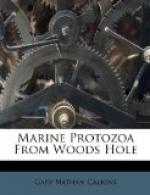Actinophrys sol Ehr., variety. Fig. 5.
Synonyms: See Schaudinn ’95.
The diameter is about 50 mu; the vacuolated ectoplasm passes gradually into the granular endoplasm. This is the characterization given A. sol by Schaudinn, and it applies perfectly to the freshwater forms. If I am correct, however, in placing an Actinophrys-like form found at Woods Hole in this species, the description will have to be somewhat modified. In this form (fig. 5) there is no distinction between ectoplasm and endoplasm, and there is an entire absence of vacuoles. The nucleus is central, and axial filaments were not seen. The single specimen that I found looked much like a Suctorian of the genus Sphaerophrya, but the absence of a firm cuticle and the presence of food-taking pseudopodia with granule-streaming makes it a very questionable Suctorian, and 1 place it here until further study throws more light upon it.
Diameter of body 40 mu; length of pseudopodia 120 to 140 mu.
[Illustration: Fig. 5.—Actinophrys sol.]
Genus HETEROPHRYS Archer.
The body is globular with but slight differentiation into ectoplasm and endoplasm; one nucleus in the latter; contractile vacuoles one or many; pseudopodia on all sides, thin, and with peripheral granule-streaming; surrounded by a globular, rather thick coat of jelly, which is hyaline inside and granular on the periphery. Fresh and salt water.
Heterophrys myriapoda Archer. Fig. 6.
Synonym: H. marina Hert. & Less. ’74.
Diameter 25 to 80 mu; pseudopodia twice as long as the body diameter; the plasm often contains chlorophyll bodies (Zoochlorella). The granular part of the gelatinous layer is thick (up to 10 mu). The spine-like processes are very thin and short. (Schaudinn ’95.) The marine form found at Woods Hole probably belongs to this species, as described by Schaudinn. The short pseudopodia which give to the periphery a fringed appearance are quite regularly placed in connection with the pseudopodia. The latter are not so long as twice the body diameter, the longest being not more than equal to the diameter of the sphere. The body inside of the gelatinous covering is thickly coated with bright yellow cells similar to those on Radiolaria. The animal moves slowly along with a rolling motion similar to that described by Penard ’90, in the case of Acanthocystis. Diameter of entire globe 35 mu; of the body without the jelly 18 mu. The extremely fine granular pseudopodia are 8 to 35 mu long. Common among algae.
This form was probably meant by Peck ’95, when be figured “a heliozooen.”
[Illustration: Fig. 6.—Heterophrys myriapoda.]
KEY TO ORDERS OF FLAGELLIDIA.
Small, body usually amoeboid; 1 or more Order MONADIDA. flagella; no mouth
Small; plasmic collar around the Order CHOANOFLAGELLIDA. flagellum




